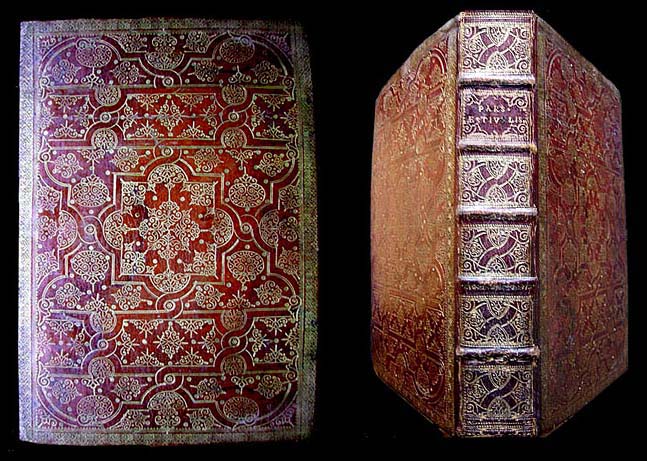

|
By a stroke of good fortune I managed to acquire this elegant Breviarium volume, bound "a la fanfare". Fascinated by the elaborate gold tooling, and curious to discover the identity of the binder, I decided to research seventeenth century bookbinding. This research eventually led me to the conclusion that this binding was produced by the Atelier Caumartin. Raphaël Esmerian, a renowned expert in the field of 17c bookbindings, has, from his extensive research, produced an comprehensive catalogue of the decorative tooling from this period: Douze Tableaux Synoptiques sur La Reliure au XVII eme Siècle, published in 1972. This catalogue is a supplement annex to the second volume of a 6 volume work entitled, "Bibliotheque Raphael Esmerian" published in French by Georges Blaizon, Paris 1972-1974. In this second volume 2eme Partie: Reliures de quelques ateliers du XVII Siècle & Livres en divers genres du XVIIe et XVIIIe Siècles he presents French bindings from several workshops of the 17th century. On page 65 we find his description of bindings which he has classified as being from the "Atelier des Caumartin". He boldly informs us that the only reason he has for choosing this designation is due to the fact that two of the three examples of this type in his collection, are found bearing the coat of arms of the Family Caumartin |
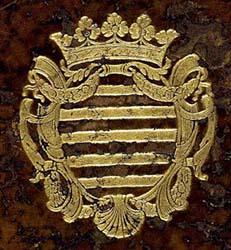
| Before I finally received the Esmerian catalogue, I had already tackled the job of identifying the binder of the Breviarium via a comparative study of the tooling imprints. (this work is outlined here Breviarium Clues). Imagine, therefore, my satisfaction to discover in Esmerian's Caumartin section of Volume 2, a photo of another Breviarium with a decorative binding very similar to my own. According to Esmerian's Table VII, this binding was executed sometime around 1685. |
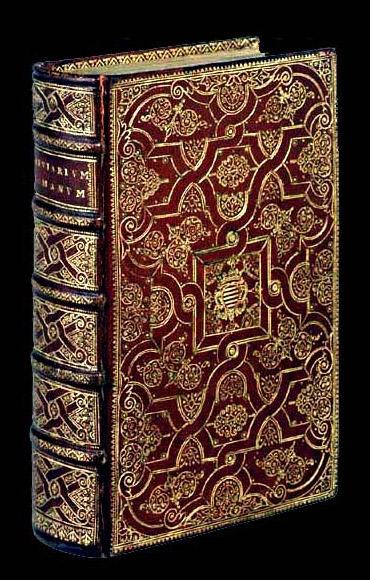
| Of the three examples figured in Esmerian's Volume 2, only one is of a quality suitable for comparative purposes, this is No. 43, which is an inside cover (doublure) from the binding of a 1666 edition of Rabelais, this binding also dates to about 1685. |
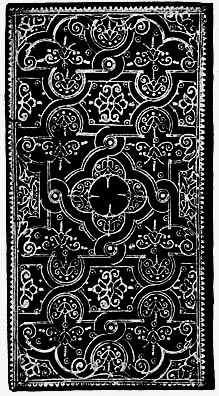
| Armed with this binding and Esmerian's Table VII - we can now compare some of the Caumartin imprints with those my 1647 Breviarium |

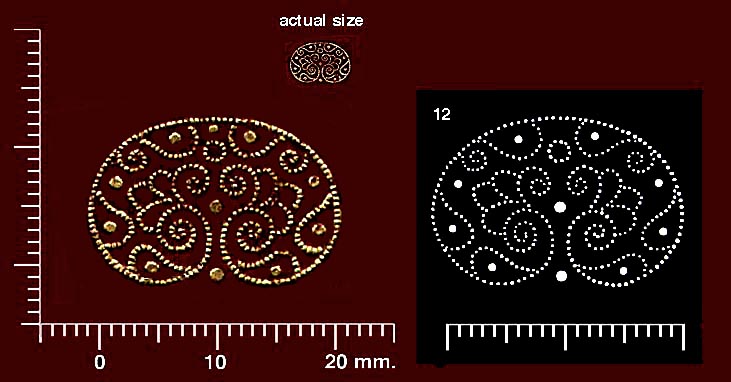
| In the diagram above I have compared Esmerian's tool #12 imprint (my numbering) to a nearly identical imprint found on my binding. The design of this stamp developed possibly from a previous tradition of linking together spiraled leaf and tendril bearing motifs, as in the central part of the detail from the BLDB example, Davis466, shown below. Variants of this tool can also be seen in the tools of Antoine Ruette. |


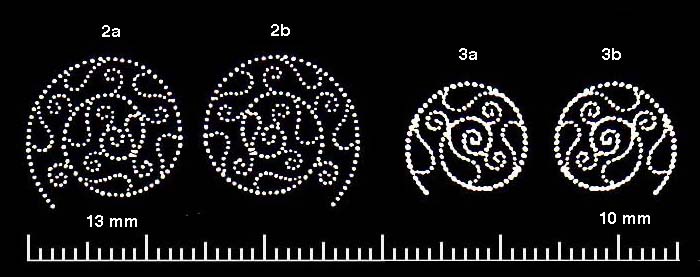
| Esmerian has not shown the spiral motifs in pairs but in fact each has an identical matching opposite. These forms developed early in the first quarter of the 17th century, as seen in the tools of Macé Ruette. At first the many spiral varients seem a bewildering jungle to study comparatively, however in these two Caumartin forms, I found a simple way of identifying them. Firstly the large 13 mm diameter examples 2a and 2b can be seen to have 7 tendrils and 7 leaves, while the smaller 10 mm diameter examples 3a and 3b have only 3 tendrils and 4 leaves. While many of the 17th century binders used tools very similar to these, the large 13 mm Caumartin form does not seem to have an equal in terms of the number of tendrils and leaves. Also it may be that the single spiral forms were replaced by the double spiral tools, which also signal a general decline in the use of these spiral motif tools. In the early pointillé work these tools were used almost exclusively and extensively to completely cover large areas in a dense maze of golden dots (filled fanfare). Later on the tooling becomes more dispersed, the tools larger and are employed less frequently (open fanfare). On my Breviarium binding, the only spirals to be found are some small 3a and b examples, barely decernible within the spine panels. |
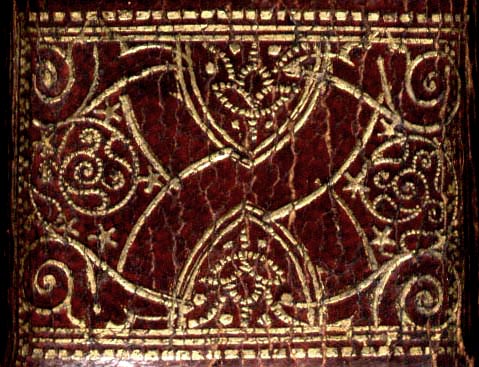
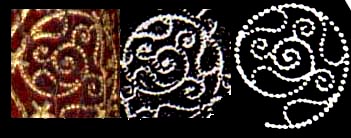
| In Comparative Diagram 3, I show a spine panel example compared with a spiral from Esmerian's figure No. 42 Breviarium and the #3 spiral in his VII table (slightly rotated). This motif is very interesting, you will notice above that Esmerian's illustrated spiral #3 appears quite different from that of #2 not just in size but in the dispersal of the dots, it may be that #3 is an illustration while #2 is a graphic produced from an actual photograph. the dots are not spaced regularly and group together to form in some sections a nearly solid line. |
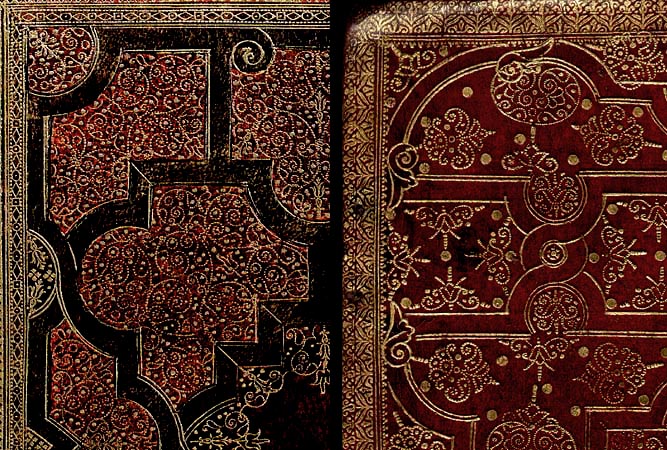
| In Comparative Diagram 4, I compare early and late pointillé examples. On the left, from Esmerian's Volume 2, figure No.4, which he notes as one of the first examples (Une des premières reliures à decor en pointillés.) this binding was executed by Macé Ruette, perhaps not long after publication in 1622. Here we see the panels or compartments well filled with spiral tools as well as other smaller tools. On the right a detail from my Breviarium which I think will prove to be from the last quarter of the seventeenth century. In this example we observe that the binder has no longer felt it necessary to 'fill' the compartments. One will notice in the Esmerian example No. 43, a number of different tool imprints which are not included in table VII, I will present these on the next page, along with those of the Breviarium as well as other diagrams to compile a more complete list of the Caumartin tools. click here to go to the next page. |
| Go to Digital Alchemy | return to the home page of cyclopaedia.org |